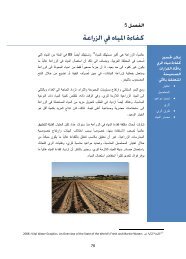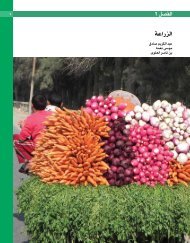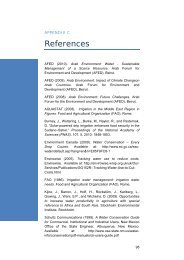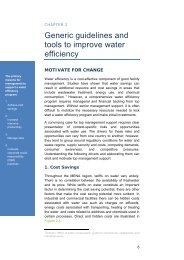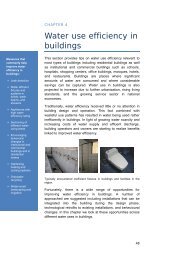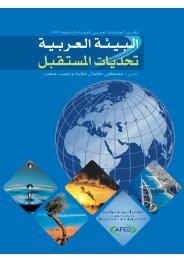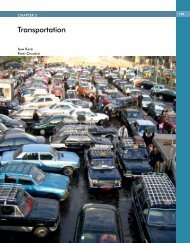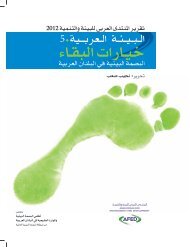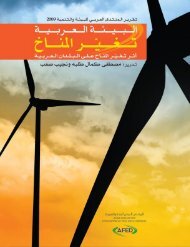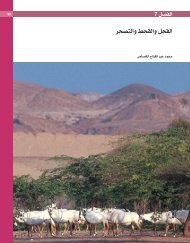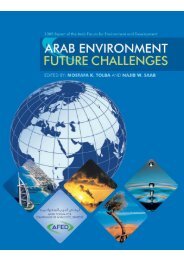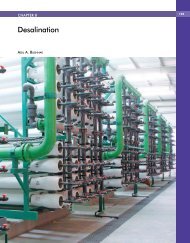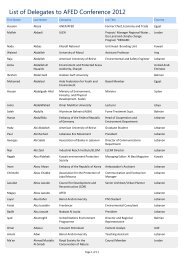Impact of Climate Change on Arab Countries - (IPCC) - Working ...
Impact of Climate Change on Arab Countries - (IPCC) - Working ...
Impact of Climate Change on Arab Countries - (IPCC) - Working ...
You also want an ePaper? Increase the reach of your titles
YUMPU automatically turns print PDFs into web optimized ePapers that Google loves.
70<br />
CHAPTER 5<br />
FOOD PRODUCTION<br />
increases in growth, but it may affect fish populati<strong>on</strong>s<br />
at the upper end <str<strong>on</strong>g>of</str<strong>on</strong>g> their thermal tolerance<br />
z<strong>on</strong>e. Increasing temperature interacts with<br />
other changes, including declining pH and<br />
increasing nitrogen and amm<strong>on</strong>ia, to increase<br />
metabolic costs. The c<strong>on</strong>sequences <str<strong>on</strong>g>of</str<strong>on</strong>g> these interacti<strong>on</strong>s<br />
are speculative and complex (Morgan et<br />
al., 2001).<br />
<str<strong>on</strong>g>Change</str<strong>on</strong>g>s in primary producti<strong>on</strong> and transfer<br />
through the food chain due to climate will have a<br />
key impact <strong>on</strong> fisheries. Such changes may be<br />
either positive or negative and the aggregate<br />
impact at the global level is unknown (<strong>IPCC</strong>,<br />
2007a). However, climate change has been implicated<br />
in mass mortalities <str<strong>on</strong>g>of</str<strong>on</strong>g> many aquatic species,<br />
including plants, fish, corals and mammals, but a<br />
lack <str<strong>on</strong>g>of</str<strong>on</strong>g> standardized epidemiological data and<br />
informati<strong>on</strong> <strong>on</strong> pathogens generally makes it difficult<br />
to attribute causes (Harvell et al., 1999).<br />
VI. IMPACT OF CLIMATE CHANGE ON<br />
FOREST PRODUCTIVITY<br />
Forests cover almost 928 thousand ha or 6.6%<br />
<str<strong>on</strong>g>of</str<strong>on</strong>g> the <strong>Arab</strong> world’s area. Approximately <strong>on</strong>e<br />
third <str<strong>on</strong>g>of</str<strong>on</strong>g> this area is located in Sudan. Modelling<br />
studies predict increased global timber producti<strong>on</strong>.<br />
Whereas models suggest that global timber<br />
productivity will likely increase with climate<br />
change, regi<strong>on</strong>al producti<strong>on</strong> will exhibit large<br />
variability, similar to that discussed for crops.<br />
<str<strong>on</strong>g>Climate</str<strong>on</strong>g> change will also substantially impact<br />
other services, such as seeds, nuts, hunting,<br />
resins, plants used in pharmaceutical and botanical<br />
medicine, and in the cosmetics industry;<br />
these impacts will also be highly diverse and<br />
regi<strong>on</strong>alized. Recent studies suggest that direct<br />
CO 2 effects <strong>on</strong> tree growth may be revised to<br />
lower values than previously assumed in forest<br />
growth models. A number <str<strong>on</strong>g>of</str<strong>on</strong>g> FACE studies<br />
showed average net primary productivity (NPP)<br />
increases <str<strong>on</strong>g>of</str<strong>on</strong>g> 23% in young tree stands at 550<br />
ppm CO 2 (Norby et al., 2005). However, in a<br />
100-year old tree stand, Korner et al. (2005)<br />
found little overall stimulati<strong>on</strong> in stem growth<br />
over a period <str<strong>on</strong>g>of</str<strong>on</strong>g> four years. Additi<strong>on</strong>ally, the initial<br />
increase in growth increments may be limited<br />
by competiti<strong>on</strong>, disturbance, air pollutants,<br />
nutrient limitati<strong>on</strong>s and other factors<br />
(Karnosky, 2003), and the resp<strong>on</strong>se is site- and<br />
species-specific.<br />
A number <str<strong>on</strong>g>of</str<strong>on</strong>g> l<strong>on</strong>g-term studies <strong>on</strong> supply and<br />
demand <str<strong>on</strong>g>of</str<strong>on</strong>g> forestry products have been c<strong>on</strong>ducted<br />
in recent years (<strong>IPCC</strong>, 2007a). These studies<br />
project a shift in harvest from natural forests to<br />
plantati<strong>on</strong>s (Hagler, 1998). Finally, although climate<br />
change will impact the availability <str<strong>on</strong>g>of</str<strong>on</strong>g> forest<br />
resources, the anthropogenic impact, particularly<br />
land-use change and deforestati<strong>on</strong>, is likely to be<br />
extremely important (Zhao et al., 2005).<br />
VII. ADAPTATION OF AGRICULTURE IN<br />
THE ARAB WORLD<br />
In 2001, the <strong>IPCC</strong> identified ìAdaptati<strong>on</strong>î as any<br />
adjustment in ecological, social, or ec<strong>on</strong>omic systems<br />
in resp<strong>on</strong>se to actual or expected climatic<br />
stimuli and their effects or impacts. This term



